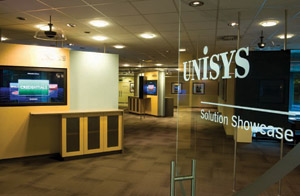Which One is Right For You?
While not the most important criteria used to distinguish between all the software vendors in the digital signage space, whether the digital signage content management software runs locally on the end-user hardware (“premisebased” or “on-premise”) or is hosted on servers off-site by a provider (“software as a service” or “SaaS”), is certainly a major consideration upon which a solution is selected.

Premise-based software has been around for quite a while and is fairly well understood. SaaS, however, is less understood, even though the concept is not new. The basic idea behind the SaaS model being that there is one version of the software running on hardware that is off-site, and users can access the software using the internet. Our company — X2O (that is spelled x2o, not X2”zero”) — offers both premise-based, and SaaS, options.
The key advantages of SaaS relate mostly to pricing and cost savings. They include:
- A pricing model based on consumption, typically a monthly payment for a predetermined number of months, which requires little to no capital expense
- Lower installation costs
- Lower maintenance costs since the vendor handles upgrades remotely
- Lower support costs as there is no hardware to worry about, no virus monitoring, etc. — those responsibilities are borne primarily by the vendor
- Access from anywhere with an internet connection
The 2010 Apex award-winning deployment at Unisys Belgium, implemented by systems integrator AVI-SPL, utilizes X2O Media’s premise-based Xpresenter digital signage platform.
The limitations of SaaS are mostly related to control, the confidentiality and security of customer data, the need for internet connectivity, and, in some cases, the ability to customize the application. Most of these issues are mitigated by vendors as they have every reason to make sure their systems run properly and that their data is secured. Also, the terms in vendor service level agreements (SLAs) — such as service up-time, maintenance frequency and times, and service rebate rules — can vary from vendor to vendor so comparisons among them should be carefully evaluated.
While resistance to the SaaS model has come down in recent years due to improvements in performance and data security, as well as a better understanding of the services rendered, a number of corporations and organizations will simply not use SaaS applications as a matter of company policy. They typically deem the security risks to be too high, and want full control over their applications. However, we have seen some organizations bend their own rules upon realizing that the SaaS solution is more beneficial for them.
For other types of customers — network operators for example — the advantages of a SaaS solution can be the difference between operating or not. For users with less up-front capital, eliminating the need for costly IT/support while experiencing lower installation and maintenance costs, in addition to no hardware expenses, makes the SaaS model the obvious choice. SaaS also helps digital signage networks scale quickly, which can be critical to their ROI in terms of revenue derived from the sale of advertising.
CONSIDERING CONTENT
Aside from these obvious cases, the decision over which type of software to purchase should, in our opinion, focus on a number of other factors. A significant factor driving the decision is the type of content to be displayed on the screens of the digital signage network. In other words, what is the digital signage network’s objective? Is it being used to inform, to increase brand awareness, to upsell products or services, to showcase, or to visualize complex data? And how does it plan to do just that? Customers need to map out their content strategy before investing in a system.

Integration with third-party systems and of dynamic, graphicrich content are criteria better suited for premised-based digital signage systems. The X2O Media deployment at the Motorola Innovation Center in Shaumberg, IL, is a great example, featuring a fully interactive and customized visitor experience, conveying Motorola’s vision of the future in an innovative way.
If the content to be displayed is fairly simple, such as fullscreen video or graphics, then an SaaS solution will work very well. X2O Media, for example, offers three different types of SaaS solutions aimed at different types of content: graphics-only applications for installations such as poster replacements, combined graphics and video applications, and a solution for graphics, video, and data-driven graphics that can easily be customized.
Content better suited to on-premise software would include graphic-rich content that changes dynamically in real time based on external triggers. For example, let’s consider the Motorola Innovation Center installation in Shaumberg, IL, which was a winner of a 2009 Apex Award in the category of “Interactivity Innovation.” The facility comprises five separate areas that highlight Motorola technology, with each area equipped with several screens that users can interact with. For instance, the Enterprise Mobility area consists of a central station equipped with an RFID interface along with four other peripheral stations dedicated to four different Motorola enterprises. When “artifacts” relating to a specific enterprise sector are placed on the RFID reader by a visitor, it triggers a specific set of playlists to play on one of the four remaining stations within the pod. A master playlist manages a number of other playlists yielding a custom, synchronized experience. In this case, an on-premise solution that allows for advanced functionality of nested playlists and real-time triggers makes more sense.
Content that requires links to external sources is also better suited to on-premise software. For example, some platforms can easily link to external systems such as Delphi — the most comprehensive hospitality software program — enabling hotel event organizers to export information such as event details, meeting room updates, and other announcements directly to display screens without having to re-key that information in the digital signage system.
USING TEMPLATES
As we evaluate the many possibilities that exist, it’s clear that there is not a simple formula for selecting a software system. The higher the customization or integration with other systems, the more likely it is that an on-premise solution will make sense. One thing that should be considered in both scenarios is the use of a template-based approach to content management. Templates are simply pre-defined layouts that can include graphics, links to data, and placeholders for other assets such as videos, images, or Microsoft PowerPoint slides. X2O Media pioneered and patented the concept of “smart” templates created in PowerPoint that contain production logic. That means content can dynamically change on screen based on information without requiring any action on the end-user’s part. This approach saves users a considerable amount of costs associated with day-to-day content management.
Maria Porco is vice president of business development for X2O Media (www.x2omedia.com), a full-service provider of software, network management services, and content services for professional digital signage and corporate communications applications. She can be reached at maria@x2omedia.com










